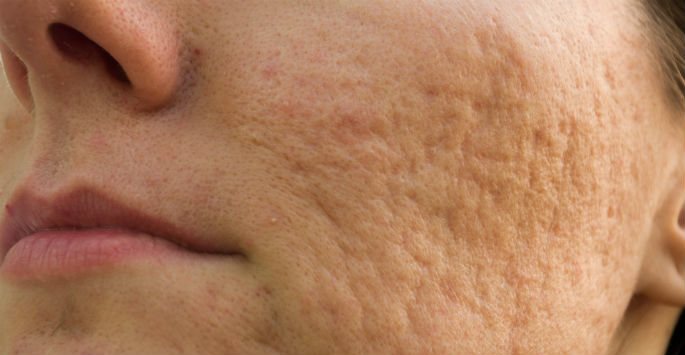Cutting-edge Acne and Acne Scars Treatment: Solutions for each Skin Kind
Cutting-edge Acne and Acne Scars Treatment: Solutions for each Skin Kind
Blog Article
Discovering Skin Disease: Treating and recognizing Acne Scars for Healthier Skin
Acne scars represent a substantial worry for individuals looking for to preserve healthy skin, as they can impact both appearance and self-worth. Understanding the numerous types of scars, from atrophic to hypertrophic, is crucial for identifying appropriate therapy alternatives.
Recognizing Acne Marks
Understanding acne scars is essential for any individual who has experienced extreme acne, as these marks can have an enduring effect on both physical appearance and emotional health. When the skin goes through inflammatory responses during energetic acne sores, acne marks form. The seriousness of scarring is often affected by elements such as the sort of acne, its period, and private skin characteristics.
The body's natural healing process can lead to either atrophic marks, which look like clinical depressions in the skin, or hypertrophic scars, which are elevated and result from overproduction of collagen. Additionally, the emotional toll of acne scars must not be underestimated; several people report sensations of shame, anxiousness, and decreased self-confidence. This psychological concern can impact social communications and overall top quality of life.
Dealing with acne scars calls for a thorough understanding of their development and impact. Recognition of the potential for lasting consequences connected with without treatment scars can motivate people to seek ideal treatments. Early intervention and efficient management techniques can significantly improve skin look and improve mental strength, highlighting the significance of comprehending the complexities bordering acne scars.
Kinds Of Acne Scars
Acne scars can be classified right into distinct types, each showing unique features and calling for details therapy methods. The key types of acne scars include atrophic, hypertrophic, and keloid scars.

Hypertrophic scars, in comparison, are raised above the skin level and are the result of too much collagen manufacturing during the recovery procedure. They typically remain within the boundaries of the initial acne sore. Keloid scars are comparable but prolong beyond the original injury site, developing bigger, elevated areas that can be unpleasant or itchy.
Recognizing these sorts of scars is vital for selecting suitable treatment choices. Various marks may respond much better to certain therapies, such as laser therapies, fillers, or medical treatments, stressing the importance of a tailored technique to acne scar management.
Recognizing Your Marks
Acne marks normally fall right into 2 classifications: atrophic and hypertrophic marks. These can additionally be classified right into ice-pick marks, boxcar scars, and rolling marks, each exhibiting unique features and needing various methods for assessment - acne scars.
Hypertrophic marks, on the other hand, are raised and happen due to extreme collagen production during the recovery process. Identifying the particular attributes of your scars-- such as deepness, texture, and size-- is essential for appropriate recognition. Furthermore, take into consideration the distribution of scars throughout your skin, as this can show the seriousness and period of the acne problem.
Engaging with a skin specialist can give important insights right into the nature of your marks, aiding in the differentiation in between numerous kinds. An extensive understanding of your marks will ultimately result in a much more customized and reliable treatment plan, making sure a clearer and healthier skin tone.
Therapy Alternatives Readily Available
Identifying the particular kind of acne marks existing on your skin lays the foundation for discovering reliable treatment options. Common types of acne scars include atrophic (depressed), hypertrophic (raised), and post-inflammatory erythema.
For atrophic scars, choices such as chemical peels, microneedling, and laser resurfacing are commonly made use of. Chemical peels make use of acids to remove the outer layer of skin, promoting brand-new cell growth. Microneedling includes tiny needles that create micro-injuries, stimulating collagen production. Laser resurfacing targets harmed skin cells, enhancing structure and tone.
Hypertrophic scars can be treated with corticosteroid i loved this shots to flatten the mark or laser treatment to minimize redness and enhance appearance. skin rejuvenation treatments. Silicone gel sheets and pressure dressings might likewise aid in managing elevated scars
On top of that, facial fillers can momentarily fill out anxieties from atrophic scars, while surgical excision might be suitable for severe instances. Each therapy choice has its benefits and factors to consider, making it necessary to talk to a skin doctor. They can offer customized referrals based on the type and extent of your scars, along with your skin kind and overall wellness.
Tips for Prevention
Reliable prevention methods can significantly decrease the chance of developing acne scars. Making use of non-comedogenic items helps stop clogged up pores, which can exacerbate acne.
Staying clear of need to pick or stand out acne lesions is essential, as this can lead to much deeper skin damage and increase the danger of scarring. Instead, consider making use of a chilly compress or over-the-counter treatments to lower swelling and redness.
Sun defense is click here to read another important facet of prevention; ultraviolet (UV) rays can darken scars and hinder the healing process. Applying a broad-spectrum sunscreen with a minimum of SPF 30 daily can safeguard the skin and advertise even healing.
Lastly, maintaining a well balanced diet rich in anti-oxidants, vitamins, and minerals sustains skin health and recovery. Remaining hydrated and handling stress and anxiety levels can likewise play a significant role in lowering acne flare-ups. By implementing these methods, people can considerably minimize their opportunities of developing acne scars.

Conclusion
Finally, understanding and determining acne marks is crucial for reliable therapy and attaining much healthier skin. Various sorts of acne scars, including atrophic and hypertrophic marks, demand details treatments customized to private needs. Treatment options array from chemical peels and microneedling to corticosteroid shots, stressing the value of consulting a dermatologist. In addition, taking on a mild skincare routine and protecting the skin from UV direct exposure can dramatically add to the prevention of further scarring and overall skin wellness.
The body's natural healing procedure can result in either atrophic scars, which appear as anxieties in the skin, or hypertrophic scars, which are elevated and result from overproduction of collagen. They are further divided into 3 subtypes: ice choice scars, boxcar marks, and rolling marks. Acne scars normally fall right into 2 classifications: atrophic and hypertrophic marks. These can additionally be classified right into ice-pick scars, boxcar marks, and rolling scars, each showing distinct features and needing various techniques for assessment.
Different kinds of acne scars, consisting of atrophic and hypertrophic marks, necessitate certain interventions tailored to specific webpage needs.
Report this page